Summer is full of many beautiful things, but it is also an excellent time for insects to be out and about. Common summer insects can even cause issues for the turf into the fall months. Usually, people are worried about flying bugs when they are trying to enjoy their lawn. However, they should actually be concerned about the insect they can’t see! They are the ones that can cause significant problems for your grass and headaches for you! Read this lawn insect identification guide.
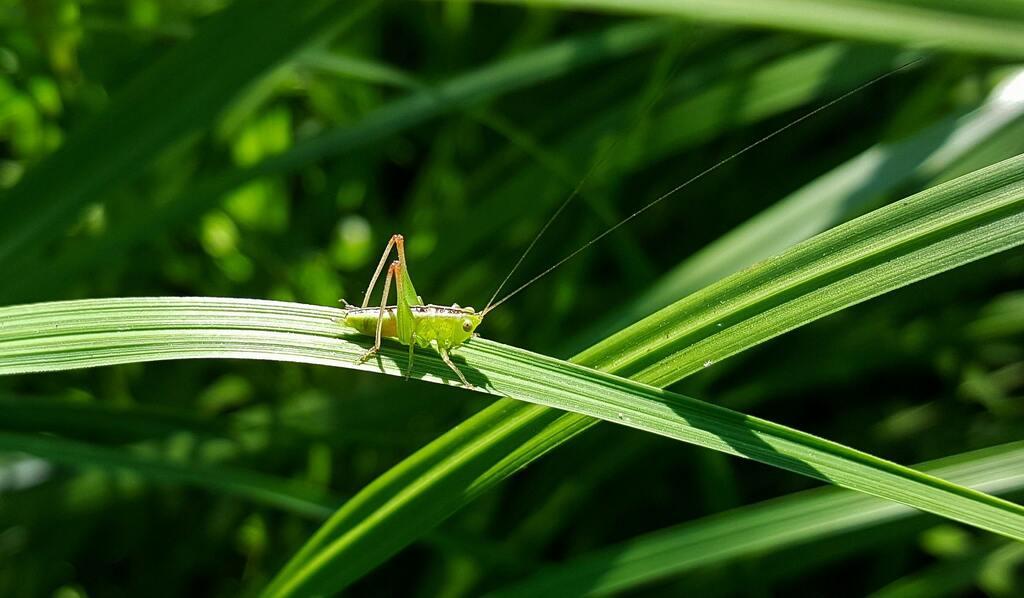
There are a variety of insects that enjoy munching on your grass, but only some of them are actually harmful.
Insects are just one of many possible reasons why your grass is thinning or becoming brown. In addition to this, turf diseases, environmental stress, and nutritional abnormalities can all be detrimental to a yard and lawn grass. If you want to be sure that the insects in the grass are a problem, you should try to observe them yourself.
Insects thrive in healthy lawns and landscapes. However, less than one percent of insect species are considered to be pests, so the ones you encounter in your backyard are probably harmless. The takeaway message is that if you detect bugs in your yard, you shouldn’t go crazy with pesticides. Broad-spectrum insecticides eliminate both beneficial and harmful insects. So, tread with care!
Whether you have cool season grasses like bent grass or warm season grasses like couch grass, we can help you correctly identify common lawn bugs and suggest the most appropriate lawn care products and insecticides accessible online.
So, read on, and we will help you learn how to recognize lawn insects and devise an effective strategy for getting rid of them before bugs destroy your lawn for good.
Lawn Insect Identification Guide
Understanding the insect at a fundamental level is an essential first step in effectively managing lawn pests. Learning about the life cycle of an insect can assist in deciding what control methods should be used and when those methods will be most successful.
Also, a commonsense approach to pest control emphasizes using the least toxic treatments (beneficial insects, biological pesticides, barriers, and soaps and oils) first and resorts to the more toxic (but short-lived) botanical insecticides only when they fail.
Nevertheless, here is a guide to the most common lawn pests and their control:
Chinch Bugs
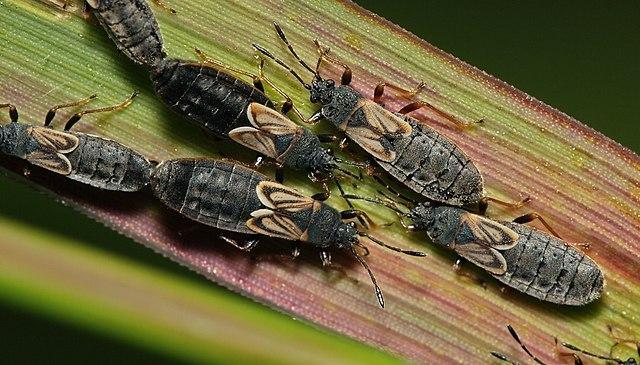
The chinch bug is a common insect found in lawns throughout the southern United States.
Sap-feeding chinch bugs are a common pest of grass. There are numerous species of chinch bugs that are responsible for damage to lawns, one of which is the hairy chinch bug, which is widespread across a large portion of the United States.
St. Augustine grass is this bug’s preferred food, and that is why these bugs are particularly prevalent in the states of Florida and Texas, where St. Augustine is a common turfgrass.
However, chinch bugs can infest lawns made of Zoysia, Bermuda, Bahia, and Centipede grass, but the damage they cause in these lawns is typically not very severe.
Ching Bugs Identification
Chinch bugs are fairly small insects, ranging in length from around 1/8 to 1/4 of an inch. The common chinch bug is characterized by a black body, white front wings, and a white hourglass form on its back. Adults can be either long-winged or short-winged.
However, nymphs that have just hatched are an orangey red color with a thin white stripe across their bellies. If you look closely via a magnifying glass at the thatch layer of your lawn, you can easily spot chinch bugs in case of an infestation.
Ching Bugs Life Cycle, Damage & Symptoms
Chinch bugs start to appear around the time of the spring equinox in March or April when the air temperature is around 70 degrees, and they lay their eggs. Parts of the Midwest see two generations per year, whereas the South sees anywhere from four to eight.
If your lawn is showing indications of drought damage despite your best efforts to maintain it with regular feeding and watering, you may have chinch bugs. Symptomatic of chinch bug damage are dried, brown patches of grass that may or may not be connected. These spots usually grow and combine into greater swaths of damage.
Damage caused by chinch bugs is often misdiagnosed as being the result of drought and hence not addressed until it is too late. If turf is simply thirsty, it should recover fast from watering; however, turf that has been invaded by chinch bugs will not.
While feeding, chinch bugs release a chemical that prevents grass from absorbing water. As a direct consequence of this, the grass wilts and eventually dies.
Chinch Bugs Control, Management & Prevention
The most effective method of eliminating chinch bugs is to apply a pesticide. Since chinch bugs develop rapidly, an insecticide treatment should be applied as soon as possible. Here are some of my favorite products for chinch bugs control:
- Ortho Bug B Gon Max Insect Killer for Lawns
- Spectracide Triazicide Insect Killer for Lawns Granules
- Cutter Backyard Bug Control
Also, plant grass types that are less susceptible to chinch bug infestations and reduce the amount of thatch in your lawn in order to prevent chinch bugs from coming back.
Related: The Best Lawn Care Schedule For Northeast | A Comprehensive Guide
Sod Webworms
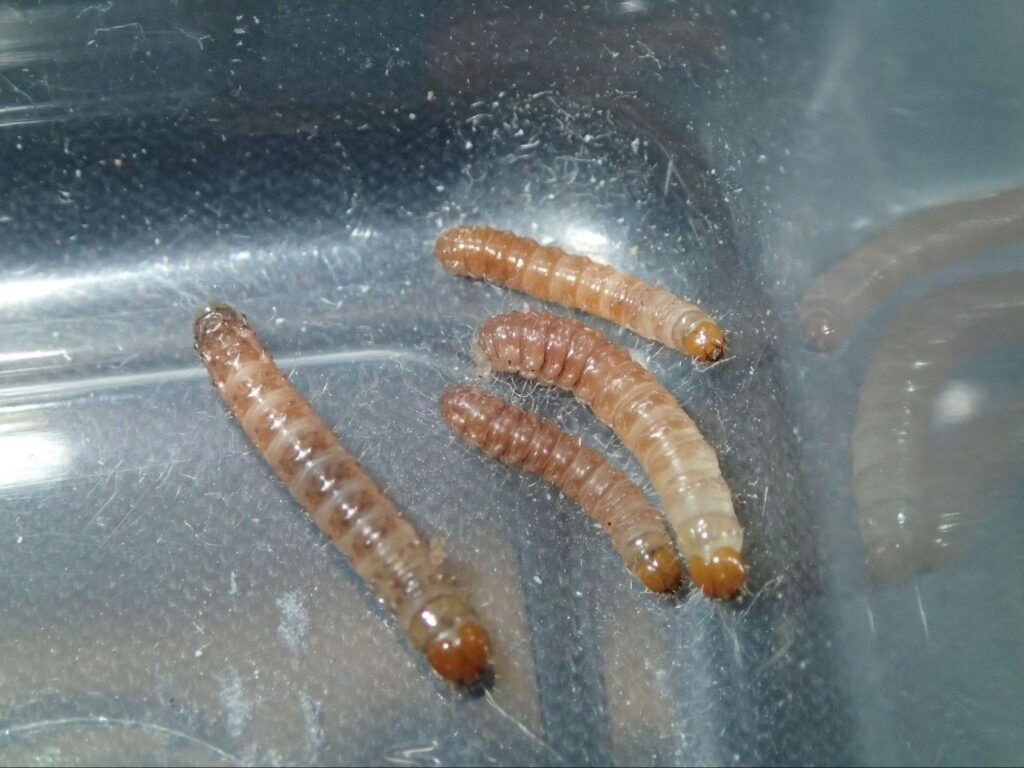
The sod webworm is a widespread late summer/early fall caterpillar that feeds on grass.
Over 20 different kinds of insects make up the sod webworm complex, and they all feed on American turfgrasses. Infestations of sod webworms can cause significant damage to lawns and parks.
It is common practice to blame sod webworms for damage to turf that was actually caused by other factors. When the grass is shallow-rooted, heat injury during extended periods of drought is often misunderstood as being caused by webworm activity.
In the same way, damage to grass caused by white grubs may look like damage caused by webworms. Grubs, however, eat the grass from the roots up; thus, patches of infested grass can be yanked up like a carpet very quickly.
Sod Webworms Identification
Depending on the species, the larvae of sod webworms can reach a length of 3/4 inch to 1 inch, and they come in a variety of colors. However, in general, sod webworms have dark heads and dark markings on gray, pinkish brown, or green bodies.
You might not notice these tiny caterpillars since they burrow below and blend in with the earth. But, if you look closely at the grass blades, you might be able to spot the little green pellets that they leave behind. Lastly, the adult sod webworm moth is brown, about 3/4 of an inch long, and has folded wings while at rest.
Sod Webworms Life Cycle, Damage & Symptoms
There are two generations of sod webworms each season. Large sections of turf may be severely damaged by second-generation infestations.
The damage done to the turf will become most apparent in July and August. The larvae of the worms that overwinter and hatch the following spring are responsible for most of the damage since they feed throughout the spring and summer.
Lawns that are plagued by an infestation of sod webworms typically have a drab, yellowish-brown coloration and an untidy appearance.
The first sign of damage in the grass is often an uneven patch denoted by very short grass that transitions from green to brown without yellowing. If a lawn is badly infested, the small brown spots will run together and create huge brown patches with an uneven shape.
“Window feeding” is another telltale symptom of impending injury. The term “window feeding” refers to the process in which the top of the leaf tissue has been removed. Whereas the remaining tissue is nearly see-through, resembling a little window.
Sod Webworms Control, Management & Prevention
Young sod webworms are very susceptible to insecticides and so easier to eradicate. Larvae are most active in the early evening, so use insecticide then.
To combat sod webworms, I recommend the following products:
But if you’d rather not use chemicals, beneficial nematodes are another option. These microscopic worms prey on and destroy webworms in the soil.
Once sod webworms have been eradicated, consistent and thorough lawn maintenance is the best way to prevent them from returning.
Two-Spotted Mites
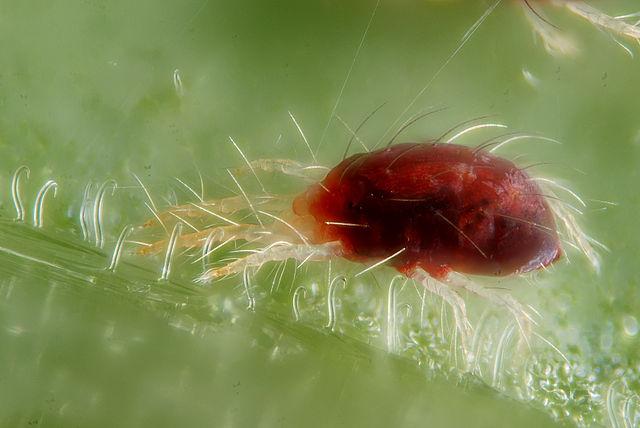
In hot, dry weather, a mite’s life cycle can be completed in as little as two weeks, causing extensive damage.
Two-spotted mites, often known as two-spotted spider mites, can be found worldwide. Mites are tiny creatures that can usually only be seen with a microscope. Mites reproduce swiftly if left unchecked. It only takes a few days for their population to grow and spread.
They are easily dispersed by the wind and can infect a wide variety of host plants.
High population density can cause severe crop damage and productivity losses. These unpleasant critters are capable, on occasion, of assaulting turfgrass lawns and causing considerable damage to the grass.
Two-Spotted Mites Identification
The two-spotted spider mite has an oval form and measures about 1/50 of an inch in length. Although it can be brown or orange-red in color, the most common hue is green, greenish-yellow, or an almost translucent tint.
The female is around 0.4 millimeters in length and has an oval body covered with 12 pairs of setae. Webbing of an extremely fine texture can be produced by heavy infestations of the two-spotted spider mite, which can cover the entire lawn area.
The presence of mites can be determined either by shaking symptomatic leaves onto a piece of white paper or by using a hand lens to examine diseased parts of the leaf.
Two-Spotted Mites Life Cycle, Damage & Symptoms
The two-spotted spider mite goes through the following phases of development: egg, larva, protonymph, and deutonymph before maturing into an adult.
Eggs can typically be discovered on the underside of leaf veins. The two-spotted mite’s life cycle can be reduced to as little as two weeks under ideal conditions, and all life phases can be present simultaneously.
The two-spotted spider mites feed in colonies on the lower surfaces of the grass blades, which they cover in fine webbing.
The feeding harm caused by two-spotted mites results in the production of minute white or yellow spots, which makes the leaves stippling or mottling.
As the severity of the feeding increases, the grass may begin to look bronzed or bleached, and the grass blades may fall off. Plants that have been heavily infested may also become yellow and dry out.
Two-spotted mites can be a nuisance in the garden, although they rarely damage turf unless it serves as a host for their initial invasion.
Two-Spotted Mites Control, Management & Prevention
Spraying with a miticide or a less toxic solution is the standard method of eradicating Two-spotted Mites. Long-lasting insecticides such as bifenthrin and permethrin are often used to control two-spotted spider populations.
However, since these insecticides also eliminate natural predators, they may ultimately worsen infestations. I have found the following to be the most effective products for eradicating two-spotted mites:
- Mite Massacre 8 oz. Spider Mite Killer and Powdery Mildew Fighter
- Forbid 4F Miticide
- Beethoven Total Release Miticide Aerosol Fogger Spider Mite Killer
Also, routine plant inspections, the introduction of helpful insects, and the physical removal of infected grass plants can help prevent further infestations of two-spotted mites.
Related: Lawn Fertilizer Schedule | When To Fertilize Your Grass For The Best Results?
Fall Armyworms
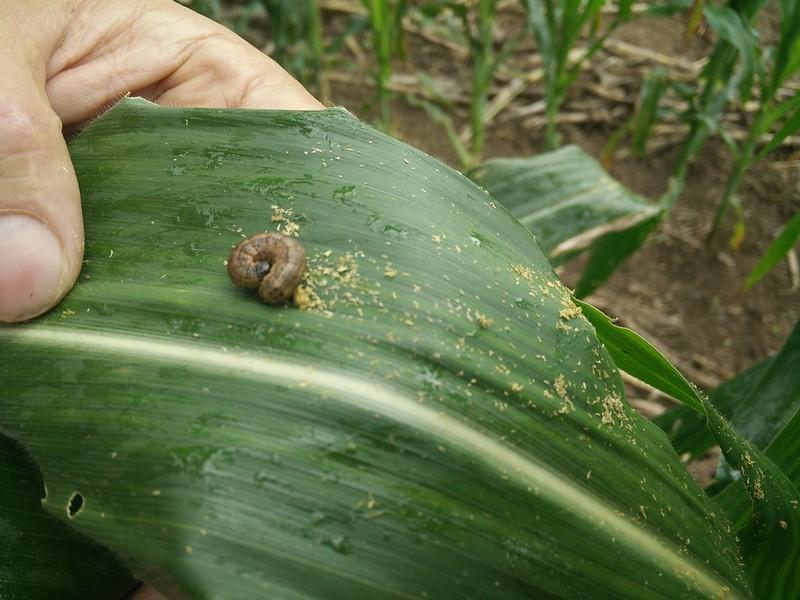
The autumn armyworm is a persistent insect that can cause extensive damage to grass in the Southeast.
Female moths can deposit up to 500 eggs on the grass or the leaves of nearby trees and plants. In less than 48 hours after hatching, fall armyworms may transform green grass and crops into a striped brown mess.
Female moths can deposit up to 500 eggs on the grass or the leaves of nearby trees and plants. In less than 48 hours after hatching, fall armyworms may transform green grass and crops into a striped brown mess.
They feed on many different kinds of plants, including turfgrasses, but they seem especially fond of Bermuda grass lawns. In addition to Bermuda grass, fall armyworms also attack bluegrass, fescue, ryegrass, and bentgrass lawns.
Fall armyworms cause uniform bare spots throughout the grass. Though they are busy around the clock, they eat most frequently in the wee hours of the morning and the evening.
Fall Armyworms Identification
The larvae of the fall armyworm can be identified in a field or on a lawn by using several key characteristics, which are listed below. The heads of fall armyworms are dark, and on the front of their bodies is a whitish Y form that is inverted.
The females are typically a little bit larger than their male counterparts. They have four dark spots forming a square on the body segment right before the last one.
Moths that have reached adulthood are around 16 to 17 mm in length and are nocturnal, with a mottled brown forewing, a white hind wing, and a wingspan that ranges from 32–40 mm.
Fall Armyworms Life Cycle, Damage & Symptoms
There are four phases in a fall armyworm’s life cycle: egg, larva, pupa, and adult. When placed on the undersides of leaves, the eggs hatch in just two to four days.
The number of generations that occur in one year in a given location varies. During the summer, the life cycle is finished in approximately 30 days, but it takes 60 days during the spring and fall and between 80 and 90 days during the winter.
The damage caused by fall armyworms on turfgrass is very identifiable. Caterpillars of the fall armyworm feed on the plant tissue of grass, causing damage to the grass. Fall armyworms are visible, feeding on tall, unmowed grass during the day.
Ripped holes in the leaves are the first sign of damage caused by fall armyworms.
The larva of the fall armyworm will consume turfgrass by devouring the foliage all the way down to the crown. An infested lawn would seem like it was run over by a steamroller, which is one of the first telltale indicators of fall armyworms.
Fall Armyworms Control, Management & Prevention
The use of insecticides, natural enemies, proper lawn care practices, and the cultivation of resistant grass varieties can all be used for fall armyworm control.
When applying pesticides, a little watering several hours before treatment may help boost larvae activity close to the surface of the lawn.
Here are a few products that I recommend using against fall armyworms:
- The Andersons DuoCide Professional-Grade Lawn Insect Control
- Syngenta Acelepryn- Dupont Insecticide
- GAIAGEN Lures – Pheromone Lure for Fall Armyworm
Lawn Grubs
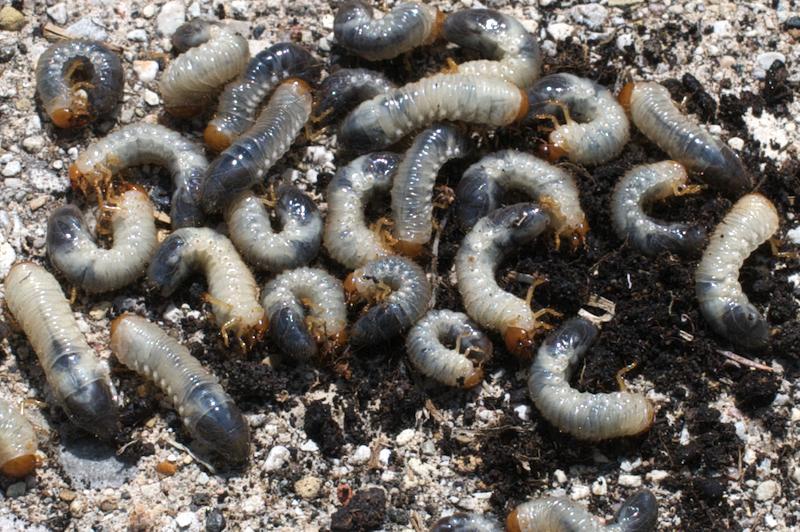
Lawn grubs are the worm-like larvae of many beetle species, such as June Bugs and Japanese Beetles.
Lawn grubs feed on grass roots (as well as organic substances in the soil), causing portions of grass in the lawn to die. There is no need to be concerned if you only have a few of these pests because they are an ordinary and necessary component of the ecosystem.
However, if you detect a large number of grubs, you need to get rid of them as quickly as possible to prevent further harm to your lawn. To your relief, there are various options for permanently eliminating these pests from your home.
First, though, we should investigate how long they last and what sort of damage they do.
Lawn Grubs Identification
Lawn grubs can be recognized by their brown heads and cream-colored grayish bodies. However, by the time you really see them, they will typically have coiled up into a “C” shape.
Cute? To be honest, no.
They will crawl across the surface of your grass and feed on the underground stems of new plants. Grubs usually do not cause damage to lawns composed of turf-type tall fescue.
However, bluegrass and red fescue are grub-prone grasses. According to research, grub damage occurs in yards when the number of grubs surpasses 8 to 15 per square foot on tall fescue and 6 to 10 on bluegrass, rye, and fine fescue.
Lawn Grubs Life Cycle, Damage & Symptoms
There are four phases in the life cycle of the white grub: the egg, the larva, the pupa, and the adult. After emerging from their eggs, the grubs will go through three different instars, or phases of larval development.
In addition, the larval stage is the one responsible for wreaking the most damage on turfgrass lawns. Depending on the species, grubs can feed for a year or more in the soil. Grubs destroy lawns by eating grass roots.
All grass can handle grub feeding, but healthier grass can tolerate more. You can check for grub damage by gently tugging on injured grass. If roots are gone, it’s grub damage.
Grub damage can also be caused by birds, skunks, armadillos, raccoons, or moles digging up your lawn. Lawns that grubs have damaged will have brown spots of varying sizes and shapes.
The month of August is often when it makes its debut, and people frequently confuse its appearance with the consequences of the drought.
However, you can easily verify this by watering the grass!
Lawn Grubs Control, Management & Prevention
Eliminating grubs before their young hatch and begin to cause harm to your grass is the most effective method for grub control. Apply a preventative grub control solution in the spring or early summer, and you’re good to go! If you miss this opportunity, you can still control them later, but it won’t be as effective.
My favorite lawn grub control products include the following:
- Scotts GrubEx1 – Grub Killer for Lawns
- Lawnbox GrubOut 100% Organic Grub Control Insecticide
- Grubs Away Systemic Insect Control
Along with controlling grubs, prevention is a must. This can be done by allowing your lawn to grow dormant over the summer when grubs are less likely to cause harm due to the dry soil.
Related: What Are Different Bermuda Grass Types, And Which Is Best For A Lawn?
Mole Crickets

Mole crickets have peculiar enlarged forelegs that are used for digging in the soil.
Mole crickets are odd-looking pests that can cause significant harm to your lawn. Although mole crickets are very widespread in the United States, the southern and southeastern parts of the US are where they do the most harm to lawns.
Damage caused by mole crickets in various southern states is estimated to be in the tens of millions of dollars, according to some estimates.
These tenacious insects are equipped with clawed front legs, making them ideal for digging through your lawn, tearing up your turfgrass, and eating on the roots.
Mole Crickets Identification
The grayish-brown, velvety body of a mole cricket, short wings, and huge black eyes make it easy to identify. Nymphs grow to be around a quarter-inch long.
They appear like adult mole crickets, just smaller. Adult mole crickets are 3 to 5cm long with small eyes and shovel-like forelimbs. The forewings are small and oval in shape, typically less than half as long as the abdomen, and the abdomen is exceptionally soft.
Mole crickets have back legs that resemble grasshoppers and have a distinctive chirping sound utilized for mating, just like grasshoppers and crickets.
Mole Crickets Life Cycle, Damage & Symptoms
Mole crickets spend most of the year burrowing in the earth close below the surface. They have three life stages: egg, larval/nymph, and adult. The overwintering nymphs reach maturity in the month of April, and around this time, often in April and May, they begin to produce eggs.
Even though these nasty bugs will eat both animals and plants, the damage they do to lawns due to their tunneling behavior is what brings them the greatest notoriety.
Mole crickets create tunnels in the top layers of the ground, which causes the ground underneath the grass to become loosened, and as a result, grass plants become dry and die. Young and previously planted lawns are particularly vulnerable to their damage.
Soil erosion and dead grass are all unmistakable indicators of mole crickets. As they burrow, mole crickets leave behind runways similar to those left by moles and uprooted seedlings. The mole cricket’s burrowing behavior disturbs the ground, killing grass and causing bare spots.
Mole Crickets Control, Management & Prevention
Soapy water can be used to remove mole crickets and their nymphs from the soil. Add about two tablespoons of dish soap to a gallon of water and use it to soak the soil. Pesticides are also viable (often required) for controlling mole crickets but have downsides. My preferred products for getting rid of mole crickets in lawns are:
There is also the option of taking a more natural method, such as eliminating them using parasitic nematodes. Yet, the best defense against crickets is a well-maintained lawn.
Cutworms
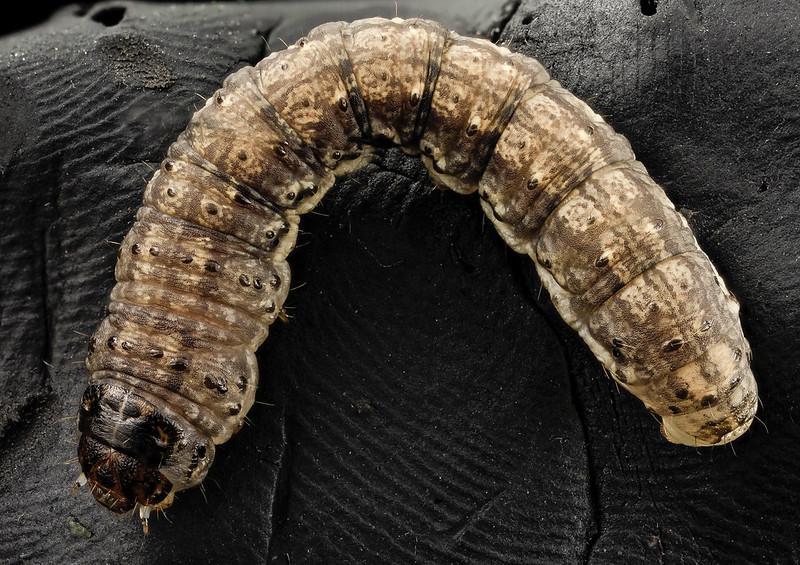
Cutworms are the larvae of certain moths, and they feed on plant roots after dark.
In terms of their general appearance, cutworms are fairly similar. However, different species can look very different from one another, and their coloration can range from brown or tan to pink, green, gray, and even black.
They measure around two inches at maturity and are hairless or have very short hair. When threatened, they often curl into a compact ‘C.’
Cutworms are frequently misidentified as the grubs of beetles like Japanese beetles (which are damaging in their own right). After hibernating through the winter, cutworms feast on young plants, causing the most damage at the beginning of the growing season.
Cutworms Identification
Cutworms can range in color from pink to green to brown to black, depending on the species, and they typically have a striped pattern that runs along the length of their bodies.
Cutworms (which aren’t actually worms) are frequently misidentified as grubs or other types of caterpillars because of their similar appearance. The black cutworm is one of the most common kinds and can be found in grassy areas and vegetable gardens.
The larvae have the appearance of grease and can reach a length of up to 5 centimeters (about 2 inches). Adult moths are brown or black with gray, brown, black, or white stripes.
Cutworms Life Cycle, Damage & Symptoms
Cutworms spend the winter as either immature or fully fledged larvae in soil or under decaying plant matter. Females lay hundreds of eggs. There are between six and seven larval stages. Pupation is underground.
The emergence of cutworms occurs during the spring. When cutworms dig through the thatch or into the ground, they can cause harm to the turf. They eat stems and blades near the earth at night.
There may be a few dead grass areas, brown crescents the size of your pinky, or even ball markings on the green if the damage is severe enough. When feeding on grass stems and leaves throughout the summer and into the beginning of fall, larvae inflict damage on the grass by eating it.
The dead sections of grass break away easily in bunches, revealing masses of silk and the green feces pellets that larvae have left behind.
The damage appears to be similar to drought. As a result, many homeowners erroneously assume that the lawn merely needs to be watered to regain its lush-green appearance.
Cutworms Control, Management & Prevention
Cutworms are a pest to both homes and farmers because they eat grass and other plants, including vegetables, ornamentals, and farm crops. Maintaining high-maintenance turfgrass free of black cutworms requires regular, careful mowing.
Cutworms are most active at night, so treating your grass in the evening is your best bet. Some highly efficient products for eradicating cutworms in lawns are listed below.
- Antixx Plus Ant Cutworm Sowbugs Cricket Slug Snail Killer
- BioLogic All-Natural Pest Control Ecomask
- Garden Safe Brand Bt Worm & Caterpillar Killer
Billbugs
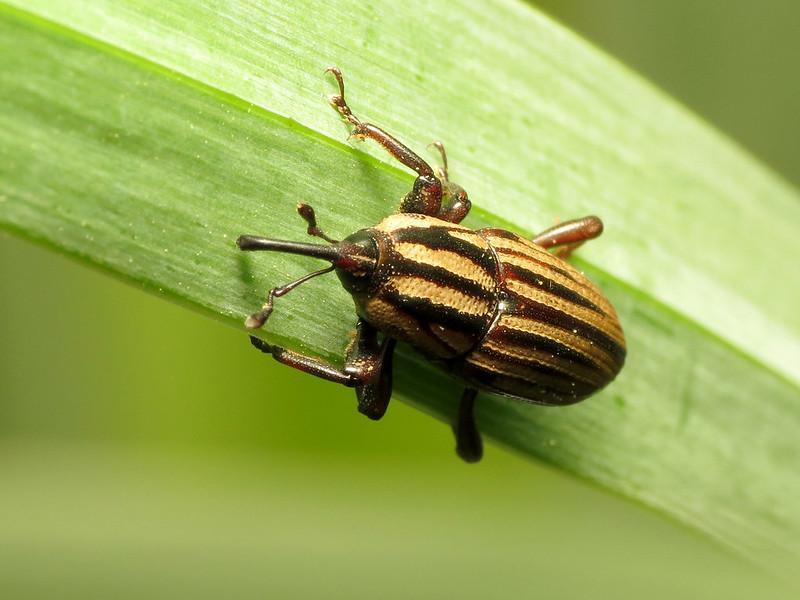
Since the late 1800s, billbugs have been recorded as major pests on lawns and other turf areas.
Billbugs are Sphenophorus weevils that have become important pests of controlled turfgrass worldwide.
These insects’ larvae cause harm to a wide variety of warm-season and cool-season grasses by eating on the grass’s stolons, stems, crowns, roots, and rhizomes.
Both billbug adults and larvae damage lawns. Adult billbugs will eat holes into the blades of grass, and then they will lay their eggs inside those holes.
When larvae hatch, they begin eating grass from the inside out, and they continue eating from the roots all the way up to the tips of the blades, ultimately killing the grass.
Billbugs Identification
Billbugs are named after their long, bent snouts. Billbugs are a species of weevil, and full-grown adults can reach a length of up to 0.5 inches.
Their tough shells can be a variety of colors, ranging from clay brown to nearly black, depending on the species, but they all have a peculiar pitted texture. The hunting billbug has a Y-shaped marking on its thorax with inward-facing parenthesis on either side.
The larvae of billbugs are white with reddish-brown heads and have an appearance that is strikingly similar to that of white grubs, which are another prevalent lawn pest. On the other hand, Billbug larvae do not have legs, although white grubs do.
Billbugs Life Cycle, Damage & Symptoms
Adult billbugs spend the winter buried in leaf litter, only emerge to make the journey to appropriate turf on sunny days. In June, adult females deposit their eggs within the turf, where they will hatch into larvae that will feed within the turf stem.
As they continue to develop, they begin to consume the grass plant’s crown. Billbug adults produce egg-laying sites by chewing holes in grass stems, typically at the plant’s crown.
Larvae hatch in the stem and tunnel into the crown or another stem. Older larvae stages will feed on the plant’s crown, which can ultimately be fatal to the plant.
The damage caused by billbugs to a lawn consists of brown, dead patches and bare sections of the soil in irregular shapes.
It is very similar to the harm caused by white grubs. Because of this, many individuals mistake them for lawn grubs and apply the wrong treatment.
Billbugs Control, Management & Prevention
In most cases, minor damage can be repaired if the billbug larvae are eradicated. You may encourage new growth in the lawn by watering and fertilizing it.
Large areas should be reseeded or resodded.
There are various herbicides available to put an end to their existence. If you have found evidence of damage caused by billbugs, you will want to implement a short-term treatment strategy and a long-term strategy for preventing more infestations.
The following is a list of my go-to products for getting rid of billbugs in turfgrass:
- BioAdvanced Complete Insect Killer for Soil & Turf Granules
- Bonide – Insect and Grub Control, Outdoor Insecticide/Pesticide Granules
- BAYER CROP SCIENCE Complete Insect Killer for Soil & Turf
Spittlebugs
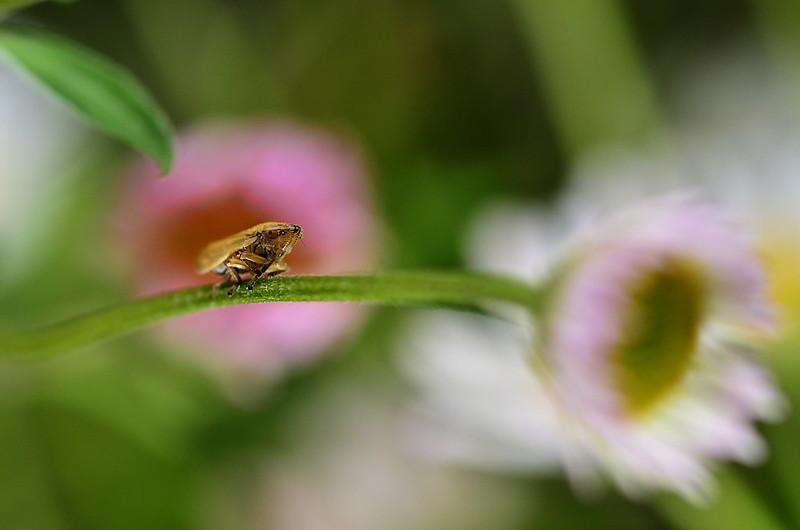
While feeding on plants, spittlebugs produce a foamy spittle pile, giving them their common name.
Have you ever seen little insects that are mostly black but have some red stripes on them? They hop around your grass, and you may also see white foam on your lawn, trees, or other plants.
If so, you’re dealing with spittlebugs, which, if given a chance, can severely damage your lawn. About 2500 unique spittlebug species have been identified so far.
The spittlebug is a master of disguise, frequently disguising itself with a foamy material. They produce this material on their backs and then employ it to protect themselves from the elements, conceal themselves from predators, and retain moisture.
Spittlebugs Identification
The presence of “spittle” is a simple method for determining whether or not spittlebugs are present. The size of these spittle masses can reach up to three-quarters of an inch.
The adults of the meadow spittlebug are about a quarter of an inch long but are rarely observed. The nymphs are located within the spittle masses of the adult.
They begin their lives green and eventually become brown or gray. They have fleshy bodies that can grow to be up to a quarter of an inch long.
Spittlebugs Life Cycle, Damage & Symptoms
Spittlebugs have three life stages: egg, nymph, and adult. Eggs laid by spittlebugs can overwinter in leaf litter and remain viable. Adult females lay eggs singly onto thin-barked twigs and juicy, green shoots or in plant crevices, using their knifelike ovipositor.
Nymphs emerge at the end of April or the beginning of May. Spittlebug nymphs feed on plant juices by puncturing the stems of plants and sucking them. The feeding of spittlebugs on plants does not typically harm the host, especially when it comes to annuals and perennials. An overabundance of spittlebugs can cause distorted leaves, however.
Spittlebugs make it clear that they are eating plants. The foam they produce can be seen as soon as they start feeding. Spittlebugs cause damage to plants by penetrating plant tissue and drawing out plant juices with their sucking mouthparts. The damage prevents the plant from growing normally and causes the leaves to become distorted.
Spittlebugs Control, Management & Prevention
Spittlebugs are only a threat when they are present in significant numbers. A powerful blast from the water hose can wash away spittle and shake loose the pests.
Spittlebugs overwinter as eggs in plant detritus, so tidy your garden thoroughly at the end of the season. On the other hand, the infestation may occasionally be on a vast scale, making the use of herbicides a potential need. Here are some spittlebug killers:
- Garden Safe Houseplant and Garden Insect Killer
- Natria Insect, Disease, & Mite Control for Indoor and Outdoor Plants
- Ortho MAX Malathion Insect Spray Concentrate
- Espoma Organic Earth-Tone Insect Control
Mealybugs
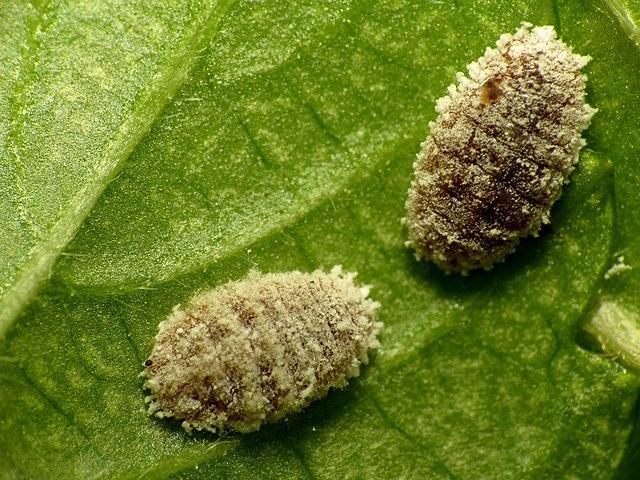
Mealybugs are little, waxy insects that can be found in gardens, landscapes, and even indoors.
Mealybugs are members of the family Pseudococcidae and are characterized by their piercing and sucking mouthparts. These tiny insects get their food by sucking the sap out of the cells or tissues of plant stems and leaves.
Mealybugs have a diverse spectrum of host grasses. Bermudagrass, St. Augustine grass, tall fescue, and centipede grass are all susceptible to damage.
They thrive in warm environments and can be brought into your house and yard by fresh plants. Mealybugs are notoriously tricky pests to get rid of, especially considering their tiny size. The plant will die if the mealybug infestation is not treated.
Mealybugs Identification
Most mealybugs live in colonies. In addition to having a waxy, flat body that is soft to the touch, mealybugs have an oval form and are segmented all over their bodies.
Sizes of mealybugs range from 1/20 to 1/5 inch. Look for white cotton-like excretions on plants to spot mealybugs or their egg sacs. These insects resemble cottony patches, especially when females produce waxy eggs.
Crawler nymphs emerge from cottony masses of eggs. The color of crawlers can range from a light yellow to a reddish hue before they start excreting a whitish wax.
Mealybugs Life Cycle, Damage & Symptoms
Different animals have slightly different life cycles. Most mealybug females lay 100 to 200 eggs in cottony sacs. After depositing eggs for five to ten days, the female dies. Young female mealybugs have three instars and are mobile. Male nymphs spin a white, waxy cocoon. Adult males are small, winged, and live a few days.
Mealybugs suck sap from the phloem of plants, which decreases the vigor of the plant. Additionally, mealybugs excrete sticky honeydew and wax, which lowers the quality of both the plant and the fruit, mainly when black sooty mold grows on the honeydew. In addition to this, the damage caused by mealybugs is challenging to diagnose.
Your indoor and outdoor plants may suffer a considerable reduction in their appearance and a large amount of damage if mealybugs are present.
When there is a high population density of mealybugs, the damage caused by their feeding can be extremely severe, as seen by the wilting and deformation of new leaves. The grass will look to have stunted and lifeless patches, much like it would if it were dying from a lack of water intermittently.
Mealybug infestation causes turfgrass to wilt and turn a stained brownish tint. Summer heat and drought typically increase the extent of mealybugs’ damage.
Mealybugs Control, Management & Prevention
You can use many methods to get rid of mealybugs from your lawn. For instance, you can spray your grass with a high-pressure hose to get them off. However, they will just return. You can use neem oil or insecticidal soap spray for a long-term fix on your lawn.
However, in extreme infestations, insecticidal sprays might become necessary. Here are a few products that you can use to get rid of mealybugs in your yard:
- Monterey Garden Insect Spray, Insecticide & Pesticide with Spinosad
- PyGanic Gardening 8oz, Botanical Insecticide Pyrethrin Concentrate
- Summit Chemical Mosquito Bits; Ready-to-Use Neem Oil
Final Thoughts
Everyone loves a good lawn but maintaining a good-looking lawn is no easy task. You must carefully deal with many issues, including grass pests.
When you know what kind of destructive insect is plaguing your yard, the next step is to learn more about that insect’s life cycle. You can use this information to better cope with the current pest problem.
In addition, before resorting to more extreme measures, the least harmful options should be explored first. However, there are situations when using strong chemicals is required.
If you go this way, be very cautious in following the manufacturer’s recommendations, and know for sure how long you have to wait before letting your kids and dogs play there.
Frequently Asked Questions (FAQs)
What is the most common damaging insect pest on turf?
White grubs are the most damaging insect pest of turf that you should be looking for. They are the larvae of numerous scarab beetles, such as Japanese beetles and masked chafers. Chinch bugs are a close second when it comes to damage caused by pests to local turf. They are capable of causing extensive and expensive lawn damage.
Which pests are least harmful to a lawn?
The least harmful pests on a lawn are ants. In fact, some people might argue that they are beneficial for turf as they keep many other pests away. However, if ant numbers become too much in a yard, they can be a severe nuisance for everything and everyone.
How do you get rid of leather jackets?
Applying a nematode treatment to the afflicted areas after rain or a sprinkler session can help get rid of leather jackets. Nematodes are very little microscopic worms that attack and kill leather jackets, as well as many other types of lawn pests.
Sources For Further Reading
Lawn Insect Pests – Gardening Solutions – University of Florida, Institute of Food and Agricultural Sciences. (2022). Retrieved 24 September 2022, from https://gardeningsolutions.ifas.ufl.edu/lawns/problems-and-solutions/lawn-insect-pests.html
Lawn Pests | Lawn, Garden Pests | Insect Information | Extension | Entomology | Kansas State University. (2022). Retrieved 24 September 2022, from https://entomology.k-state.edu/extension/insect-information/lawn-garden-pests/lawn-pests.html
Lawn Insect Management Guidelines–UC IPM. (2022). Retrieved 24 September 2022, from http://ipm.ucanr.edu/PMG/PESTNOTES/pn7476.html
Lawn Insects | University of Maryland Extension. (2022). Retrieved 24 September 2022, from https://extension.umd.edu/resources/yard-garden/lawns/lawn-insects
Lawn insects. (2022). The University of Minnesota Extension. Retrieved 24 September 2022, from https://extension.umn.edu/yard-and-garden-insects/lawn-insects
Editor’s Recommendations
Can I Use Care Oil In My Lawn Mower? Mystery Solved!!!
The Best Reel Mower For Home Lawns | A Comprehensive Guide
Brown Spots In The Grass: Causes, Solutions & Prevention | A Comprehensive Guide







